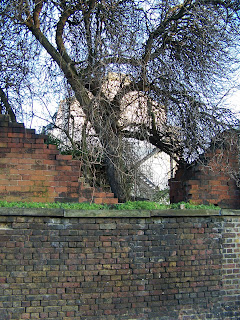An All Saints Day
Let me tell you a little about my Sunday. I went to three churches, attended two and a half services and an organ recital.
I attended my usual service at St Augustine's Church Highbury New Park from 10:30-12. Actually, I stayed until 12:30 talking. It is Anglican, but clearly a believer’s church, very friendly, informal and family friendly. Lots of kids. Great pastor about my age.
My comment, “Anglican but clearly a believer’s church” comes from my background, I am afraid. We used to say, with a large hint of incredulity in our voices, “he’s Catholic, but he’s a Christian.” We often treated main-line denominations this way, sometimes as a matter of course. Living in London and attending St. Augustine’s has been humbling for me in this respect.
Before service at St. Augustine’s, I attended Mattins at an old old church abutting Clissold Park, a 10 minute walk from our flat. We have gone many times after dinner to walk the paths. We passed this old church building many times, and I wanted to see the inside, but the gates have always been locked. So I noted the service time in case I should have opportunity in the future.
Yesterday I went.
Mattins is a service of prayer, hymns, liturgy, and Bible readings. The term as I understand it essentially refers to the time of day, morning, and indicates worship. I walked in at 9, midway into the first hymn. There were four of us in the pews, all older people, as one might expect. I was the only young person there, but my white hair helps me disguise it. Then there was a priest leading the service and directing the liturgy, and also an organist.
The interior is tiny, with latched doors on the well worn pews, cracks in the plaster on the walls, marks of use everywhere, and different building materials. Columns made of sand stone on one side, red bricks on the other; to the front, wood panels about five feet high with faded gold-painted inscriptions below the stained glass window showing Mary and the Christ child.
I sat in the last pew, trying to be inconspicuous, clumsy as I was finding my way through the book of common prayer, the hymnal, the order of service, and the liturgy pamphlet. Too many things for a plainspoken Baptist to handle; too many places to look. Five rows ahead of me, the other three congregants occupied the front row!
To my great amazement, in this tiny place, being played with great skill and sensitivity by a man with a great grey beard and a tweed jacket, was a pipe organ!
Anyway, I felt the service, strange as it was to me, was spiritually meaningful. I prayed for many people, including myself, during intercession time. The word of scripture spoke to me.
Originally built in 1563 to replace an earlier church on that site dating from 1100, St. Mary’s had taken a direct hit during the Nazi blitz, now 70 years past. The demolished brick wall was replaced with sandstone blocks. The other male congregant told me the post-war rebuilders had done a poor job, so the church was raising money to reconstruct the reconstruction.
He noted that St. Mary’s is one of very few surviving Elizabethan churches. Besides dating from Shakespeare's era (!), I found his little footnote both puzzling and humbling. Puzzling because of the destruction and rebuilding: How much need be saved to let us say the church “survives”?
Humbling because uncounted generations of believers, the Church itself, have worshiped in that place.
In the late afternoon I went to St Paul's Cathedral, which is very very high church. Huge, ornate, prosperous, well maintained, impressive and noteworthy in many respects. And clearly, too, a believer’s church, although one might miss that for all the magnificence.
What I missed was the early part of Evensong because the buses run less frequently on Sundays and I had not accounted for a travel delay.
This service, too, was without a sermon. Most of it was sung by an all male choir, professional essentially, which sounded other worldly in that huge space. After Evensong I stayed for an organ recital, which was compelling and profound. I say as much even though organ is not always my favorite instrument.
My notebook records this: The organ fills the enormous space like a deep and prolonged thunder on a hot summer afternoon. One has the feeling that a great dark bank of clouds should be rolling in. We expect the ray of sunlight to break through. I look up and the word GREATNESS on a gold background seems to jump out at me.
When it ended, I was somehow both energized and exhausted.
Then I walked several miles through center London to the spot where I often pick up the 19 bus home. I could have taken another bus from right outside St Paul's, but it had stopped raining and dusk had not descended. And I needed to walk. I needed time for my day of worship to work itself out in my heart.







































